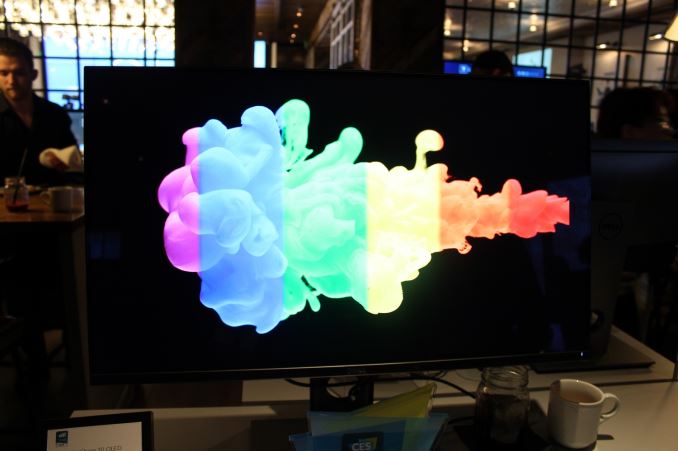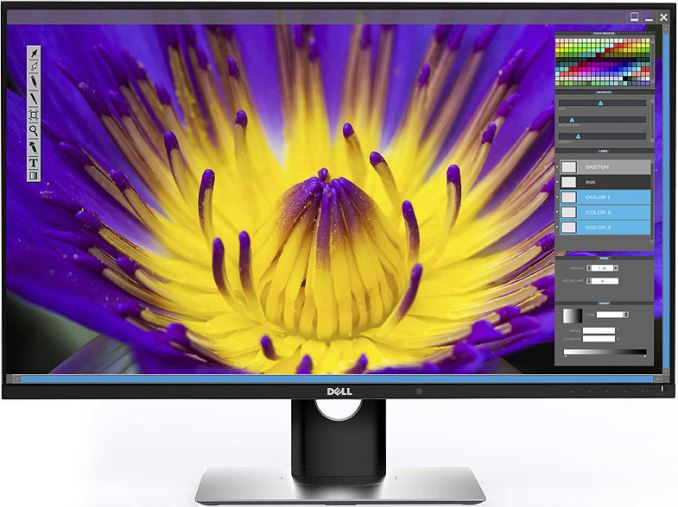Dell Demonstrates 30-inch 4K OLED Display
by Anton Shilov on January 7, 2016 6:40 PM EST- Posted in
- Monitors
- Dell
- Trade Shows
- 4K
- Ultrasharp
- CES 2016
- 30"
- OLED
- UP3017Q

Dell does not produce its own display panels, but when it comes to unique “world’s first” monitors, it is sometimes years ahead of all of its rivals. At the International CES 2016, Dell introduced its UltraSharp 30-inch OLED display, the company’s first monitor to use organic light emitting diode panel. The product is designed for professionals and carries a rather extreme price tag, but this is going to be a dream display for years to come.
The Dell UltraSharp UP3017Q is a 30-inch display with 3840×2160 resolution, 0.1 ms response time and an unknown refresh rate (yet, it should be very high). The monitor can reproduce 1.07 billion colors, it covers 100% of Adobe RGB color space as well as and 97.8% of DCI-P3 color space (used for digital movie projection by the U.S. movie industry and is expected to be adopted in televisions and in home cinema), according to Dell. Just a few professional displays nowadays cover 100% of Adobe RGB. The manufacturer declares 400,000:1 dynamic contrast ratio, but admits the value is only that because testing equipment won't go higher.
The UltraSharp UP3017Q ultra-high-definition display has very narrow bezels; the monitor itself is thin, but not remarkably thin like OLED TVs, possibly because it features internal power supply unit as well as complex logic inside. The monitor features a mini DisplayPort (mDP) connector, an HDMI port as well as a USB type-C port, which could be used for video and data connectivity as well as for power delivery (it can be powered using a type-C cable, or deliver power to another device).
Emissive electroluminescent layer in organic light-emitting diode is made of organic compound that emits light in response to an electric current. The organic semiconductor layer is situated between two electrodes and does not require a backlight. As a result, it can display truly deep black levels, unlike liquid crystal display (LCD) panels, which use various kinds of backlighting. Besides, since the emissive electroluminescent layer is very thin and can take different shapes, it is possible to build ultra-thin and even curved monitors and TVs using OLEDs.
While OLED technology can deliver deep blacks, high contrast ratio and exceptional colours, it is not free of drawbacks. The organic layer may burn down over prolonged amount of time, and colors can shift over time. To maximize lifespan of the OLED panel inside the UltraSharp UP3017Q, Dell integrated a special presence detector into the front panel of the display, which switches the monitor off when nobody uses it. Another disadvantage of OLEDs is a possibility of static image burn in. To reduce the chance of burn in, the UP3017Q has a special pixel-shifting technology.
The Dell UltraSharp 30 OLED monitor will cost whopping $4,999, which it becomes available on March 31, 2016, in the United States. The display at this point is only aimed at professionals, who work in color-critical environments such as graphic arts and photography. However, due to exceptional colors and contrast as well as ultra-fast response time, the UltraSharp UP3017Q will be a dream display for gamers, prosumers and other users, who value quality.
OLED panels are considerably more expensive to produce than modern LCD panels, partly because of lower yields. Last year an executive from LG Electronics said that yields of OLED panels had reached 80% and would continue to grow. At the International CES 2016, Kwon Bong-suk, the head of LG’s TV business, said that the company had cut prices of OLED TVs in the U.S. by 45% late in 2015. As a result, LG now expects sales of OLED televisions to triple this year. Price reduction of OLED TVs indicates that production costs of organic light-emitting diode panels are going down. Perhaps, over time, the Dell UltraSharp UP3017Q will also become more affordable, or Dell will release an OLED display for a wider audience.











83 Comments
View All Comments
Pinko - Friday, January 8, 2016 - link
that what I meant. DirectX supports 10bpc but no application is using them. Same for OpenGL. Developers don't use them as application dev platform. It's been an epic fail. Of course I'm NOT talking of game's world.And most of GPU drivers don't support more than 8bpc either. Only some professional cards does really use 10bpc, e.g. Quadro from Nvidia. But then professional applications do NOT render images in 10bpc.
NVIDIA Geforce graphics cards have offered 10-bit per color out to a full screen Direct X surface but, due to the way most applications use traditional Windows API functions to create the application UI and viewport display, this method is NOT used for professional applications such as Adobe Premiere Pro and Adobe Photoshop. These programs use OpenGL 10-bit per color buffers which require an NVIDIA Quadro GPU with DisplayPort connector. But the cover of 10bpc output is still limited.
30 bit workflow is far from being mainstream at the moment.
Nintendo Maniac 64 - Friday, January 8, 2016 - link
Ehem:https://www.youtube.com/watch?v=X-MXyvD3iRA
Pinko - Sunday, January 10, 2016 - link
ehem! it's only the driver... and the apps??DesktopMan - Friday, January 8, 2016 - link
"an unknown refresh rate (yet, it should be very high)", depends, might not even be enough bandwidth for 120Hz depending on what signalling standard it uses.Shadowmaster625 - Friday, January 8, 2016 - link
What is this, 2013? For $5K this should be an 8K panel.Hulk - Friday, January 8, 2016 - link
With the burn in issue of OLED and the really high price I'm wondering if LCD with large array backlighting to increase contrast ratio but be a very competitive technology well into the future. The technology is proven and has become very cheap. OLED has been "just over the horizon" for quite a few years now.Magichands8 - Friday, January 8, 2016 - link
This looks like a very nice monitor but this has already been done before by Flanders and Sony. Although it's nice to see OLED becoming more common at competitive prices. Still though, I'd probably go with an Eizo CG318-4K if I had to choose between the two :) The burn-in issues with OLED scare me too. I would be willing pay this much for this caliber of monitor but every two or three years due to burn in issues.bill44 - Friday, January 8, 2016 - link
Wake me up when it's half price, supports HDR and 100% P3. Video editor will need this. LG 2016 OLED TVs will have 99% P3 (no tested yet), HDR is here to stay. There will be PowerDVD and other UltraHD BD playback software with HDR support sometimes in 2016.If, if it supports 120Hz, does this means 3D stereoscopic.
Wolfpup - Friday, January 8, 2016 - link
I like Dell's monitors, but this needs way more ports, and I'm pretty iffy on OLED period. People praising OLED usually seem clueless that LCD isn't like one type of panel, but bajillions of possible qualities of panel, many of which are extraordinarily good...and they have virtually no downsides and last effectively forever.Even within a type of tech, quality ranges massively. Like TN, thought of as the worst (modern) type of LCD panel, can vary from really bad, to very high quality. I switched from an MVA/PVA panel years ago to a really good TN panel, and while I'd love something better still, it's got an awesome selection of ports that I use daily and that's hard to find. (It's a Dell too, as was my previous one.)
poohbear - Friday, January 8, 2016 - link
make one 1440p (or heck even 1080) with 120hz+ and I'll spend up to $1500 on it! 4k simply isn't feasible for most gamers.....and if i were to choose between OLED & 4k i'd DEFINITELY prefer the OLED no questions ask.